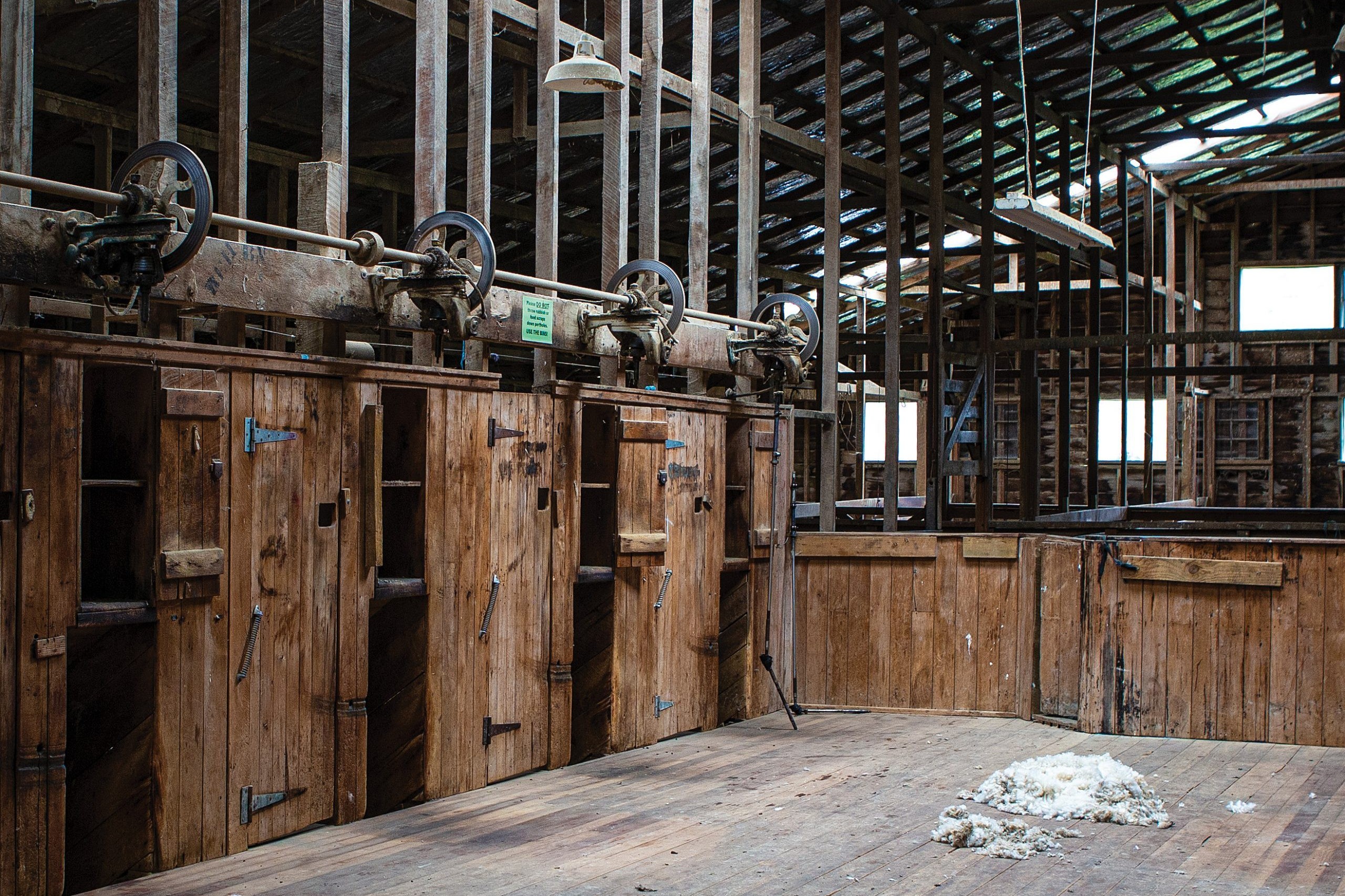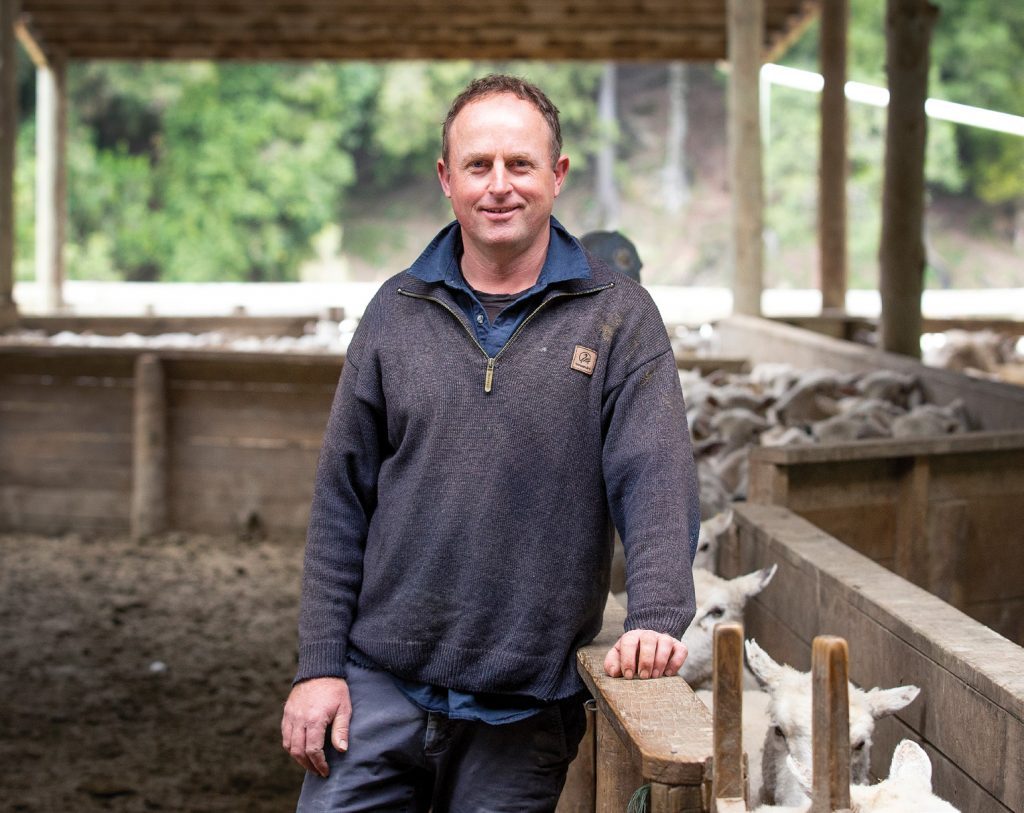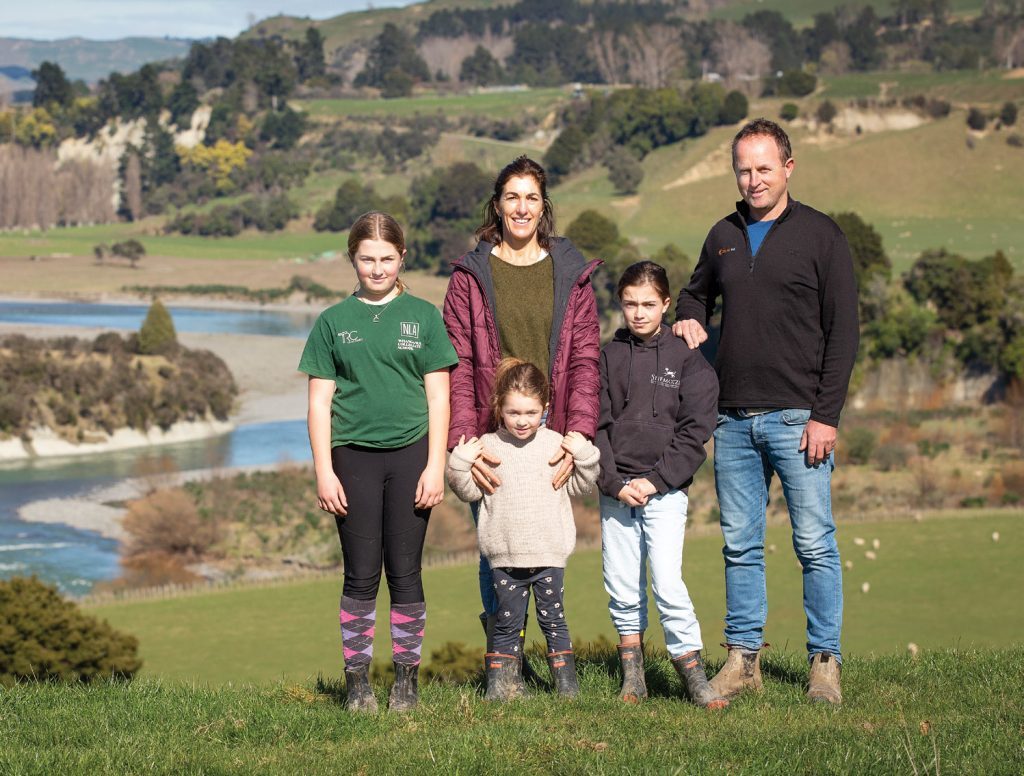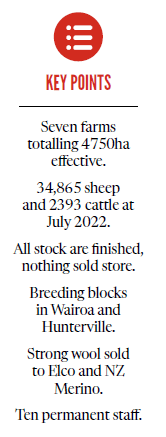Strength in numbers
A sheep and beef operation that began more than 70 years ago with Siberia Station in the Turakina Valley now incorporates seven farms. Story and photos by Sarah Horrocks.

A sheep and beef operation that began more than 70 years ago with Siberia Station in the Turakina Valley now incorporates seven farms. Story and photos by Sarah Horrocks.
JAMES HURLEY IS A HUMBLE, UNASSUMING GUY, and the third generation to farm Siberia in the Turakina Valley, 35km northwest of Hunterville. His grandfather bought the 2950 hectare (effective) steep, hill country station in 1949 and it’s since grown into a large-scale, multi-property operation.
James came home to the business in 2000 to work alongside his father Mike, who dedicated his entire working life to Siberia and the farming community. Mike retired from farming in 2019 but likes to keep an interest in the farming calendar.
The business is largely protected from the fluctuating store market and now has a good balance of breeding and finishing farms that feed off one another.
Starting with the Siberia Station, the operation now includes a 1100ha leasehold farm in Wairoa and five finishing blocks in the Rangitikei and Manawatu.

“The finishing blocks are critical to ensuring all stock, sheep and cattle, can be finished by us and nothing is sold store,” James says.
James and wife Sarah live on Waipa, a 46ha block near Hunterville, with their three daughters Rosie (13), Sabia (11) and Grace (4). The other four blocks total 774ha and are a combination of owned and leasehold land in Feilding, Rewa and Hunterville.
The July figures had the company, Siberia Station, running 34,865 sheep and 2393 cattle – enough to keep James on the road from dawn till dusk.
“I’m the glue that holds everything together, but I have some bloody good staff around me.”
All the breeding happens at Siberia and Wairoa, with Romney-Kelso cross ewes run on both farms. The rams are a mix of Kelso from Hawke’s Bay and Romney from Ngaputahi Station in Ashhurst.
James has found that the combination of the Kelso and Forbes Cameron’s Ngaputahi Romneys perform well under stress and even in a dry year the ewes will always get back in lamb.
“Forbes’s rams are bloody hardy and they’re really good in our steep country,” he says.
Siberia runs 15,000 ewes and 4800 hoggets, which are put to the ram on April 1 (4500) and mid-April (main mob) for a lambing date of mid to late September.
Only the two-tooths and hoggets are scanned as they don’t tend to get many dries, and James doesn’t have enough paddocks for the twins so finds it simpler to keep them mixed together.
Scanning percentages from the two-tooths at Siberia are 165–170%, scanning 172% in 2022. Docking percentages across the entire flock are 135–140%.
Any dry two-tooths are culled and the hoggets are only scanned as wet/dry – being given a second chance if they’re dry.
“I get a wet-dry tally from the younger sheep to give me something to put in my notebook and keep track of progress,” James says.
He believes mating his hoggets helps his whole programme, exposing them to breeding at a younger age, and bettering his two-tooth lambing results.
“Our main priority is getting our hoggets and two-tooths up to weight for mating.”
Lamb finishing is a huge part of the overall operation and for this reason 11,000 of the Siberia flock are put to a terminal Kelso ram. Some of these head to the works straight off mum in early December at weaning time. The rest are weighed, drafted into mobs, and then trucked down to the finishing farms in waves – every four to six weeks starting December 1. All lambs are finished and an additional 2600 trade lambs were brought in last year.
About 2000 one-year ewes go to the terminal ram, but these are grazed on the hills of the Rowe finishing block that straddles the Rangitikei River. Its 200ha of easier hills provides kinder country for them. With an earlier lambing date at the end of July, these lambs and ewes are all killed during November.
Steep, hard country
Siberia is steep, hard country with the majority of paddocks 70–100ha.
Chicory and swedes have been grown in the past on the 20–30 hectares a tractor can get over, and they’ve also done some hill country cropping, but James found it to be too expensive.
“I couldn’t get value for money out of the new grasses with such big paddocks and the steeper contour, so we stick to a low input, low cost system.”
The finishing blocks on the other hand, are a finely tuned, high input system. It’s all new grasses on a five-year rotation. All the lambs on the finishing blocks are fed chicory until the winter, when they’re pushed on to new grass. About 80ha of chicory is planted annually through a contracting business owned by James and his extended family. It stays in for two summers before they direct drill ryegrass through it in the autumn, so they always have 160ha of chicory over the summer months. James says doing the work themselves means they can be picky with their timing and make sure everything goes in at exactly the right time. The lambs are set stocked on the chicory and then rotated once the growth starts.
“Chicory goes through growth spurts like grass, but the fluctuations are bigger, so at times you’ve really got to stay on top of it.”
A tally of 22,000 home-bred Siberia lambs are finished through Silver Fern Farms annually and some are on contract premiums. The home-bred lambs are able to be processed through the SFF 100% programme but any trade lambs need to be sold in separate lines.
Wairoa provides a good top up for the lamb tally, with another 5000 Romney-Kelso cross ewes and 1200 hoggets.
“This is where everything kicks off for us each season,” James says.
The lambs are weaned on 1 November, which is complementary to the rest of the system.
About 2000 lambs are trucked from Wairoa to the finishing blocks in early November, about a month earlier than Siberia’s lambs start coming in. The remainder are able to be finished straight off the station in Wairoa as 25–30% of the land there is easier country.
The scanning and docking percentages are similar to Siberia, however the hoggets are only mated if the season allows.“Having the Wairoa lambs come down in early November gives us the ability to provide SFF with year-round supply.”
James targets 20kg carcaseweight (CW) over summer and in winter, usually 20kg CW for females and 21kg CW for males. Last season was their best ever for lambs, docking just over 33,000 lambs across the entire operation and killing 28,500.
“This winter has been a real struggle as it’s been really wet and we’ve not been able to fully utilise the feed.”
And James says there was also a lot of worm burden in the autumn so consequently lambs have been killed down on usual, some as low as 18.5kg CW.
Ewes are all given a Bionic capsule pre-lamb, and the lambs are all drenched every month from November. However, James found drench to be less effective earlier this year after a challenging wet autumn. He uses Zolvix strategically once a year, and only as a last resort.
Monitoring faecal egg counts
James and his staff monitor the faecal egg counts, especially at Siberia and Wairoa, and make the call on whether or not to administer the exit drench a couple of weeks before the ram goes out.
Facial eczema isn’t really an issue at Siberia, since James is buying FE-tolerant rams, but he does need to keep an eye on it at the finishing blocks.
“Last year we spent $315,000 on animal health over 53,000su.”
Fertiliser is another large, seemingly never-ending cost, which varies year to year depending on the season. Siberia gets it flown on in a yearly rotation – a third gets DAP at 100kg/ha, a third gets 250kg/ ha sulphur super and the other third gets rested.
Olsen P levels are about 25–30 on the better country, but on the steeper hills it swings from 7–20 within a matter of metres.
“You’re throwing a huge amount of money at guesswork and it’s never going to get right up there but I’d be happy with levels of around 15.”
In saying that, if fertility is good, James won’t put 250kg/ha of super on just to tick that box if it’s not needed.
With an elevation of 250–680 metres above sea level, Siberia’s grass curve doesn’t really get going until November. So the 4500 earlier lambing ewes are still cheating the grass curve. That same fertiliser policy is run on the Wairoa farm, however, on the finishing blocks soil testing is done on a paddock by paddock basis.
Bec Simpson from Ravendown has an inside knowledge of the overall business and has been handling all the soil fertility for more than a decade. James says Bec ensures the fertility levels are all there on a paddock by paddock, crop by crop basis, depending on the soil type.
“Our pH is around 6 and within reason, we just put on whatever is needed to ensure we get maximum results out of our crops and grasses.”
James has pulled back on nitrogen in the past six months due to the price increase.
The wool clip
With wool, James has fostered long-term relationships and entered new ones, to ensure he reaps as much reward as possible for the 220,000kg produced by the company each year.
Siberia shears six monthly, in January and June, with the lambs also being shorn at weaning. The ewe wool clip averages 35–36 micron and all goes to Elco in Whanganui, with the majority destined for Bremworth contracts.
“Our family has a long-standing relationship with Shane Eades at Elco and I really value that,” James says. The Wairoa clip is all going to The New Zealand Merino Company (NZM) through a relationship that James forged 12 months ago.
“NZ Merino are miles ahead of everyone else in terms of developing new markets for crossbred wool.” James was keen to be part of their cutting-edge philosophy and take advantage of the new markets they are opening up with their ZQ and ZQRX strong wool programmes.
“There are so many options given in regards to different markets and the relevant specifications that your wool may be able to fit into.”
Wool must meet the set specifications for vegetable matter, colour, micron and staple length in order to be eligible. Over the past 12 months, the wool clip in Wairoa has been sold into a wide range of different markets – the AA lines have gone to Bremworth, who have recently made the bold move to manufacture their carpet with 100% NZ wool. The various bellies/pieces lines have gone into the IKEA rug programme, which sells bespoke hand knotted rugs around the world, and some of the lambs’ wool lines have gone to Scandinavian outdoors brand Fjallraven.
Overall, results showed that the wool was sold at more than 35% above standard auction pricing at the time.
The relationship with NZM suits Wairoa as the only North Island store happens to be in Napier, so cartage is low at $15/bale. James says in comparison, if it were shipped from Siberia it would be $35/ bale.
“The price I receive per kilo is comparable between the contracts on the two stations.”
Shearing still runs at a loss on both farms and although realistic about a potentially “big future” in the strong-wool industry, James does believe it’s improving year on year.
“Ultimately we’re striving to supply consumers with premium products that meet their demands, while farming in a sustainable environment.”
James has carried out extensive work fencing waterways on all properties and planting the banks with natives wherever possible.
Steep gullies have been permanently retired on both Wairoa and Siberia, and more than 500 poplar poles are placed in strategic plantings annually. They recently fenced and planted a large waterway on the Feilding farm with the assistance from Horizons.
Pine trees are not popular, with just 10- 15ha of Siberia planted.
“They’re not in the ETS so I plan to get rid of them and plant natives for future generations.”
James jokes that he believes planting pine trees would simply line his pockets for retirement, while infuriating the next generation. That overall sense of positivity and community runs right through the operation, and James is determined to ensure it generates enjoyment, while providing a culture with character.
Many of his 10 permanent staff have been working with him for more than 10 years. Siberia has the highest weighting of staff, with Alex Matthews managing it plus two shepherds and two generals. Alex and his wife Emma moved to Siberia in 2019 after James and Sarah moved into James’s parents’ house at Waipa, bringing their young family closer to Hunterville. Leon Robinson manages the Feilding farm and the Wairoa manager is Kent Birrell, who was at Siberia as a young shepherd and who has one shepherd working alongside him.
“Siberia is an incredible place to live, the community is fantastic and it really is a completely different way of life,” James says.

Cattle for the win
James runs 150 cows on Siberia and 250 on the Wairoa farm. These are all straight-black Angus and a small part of the overall cattle operation.
“We need the cows to clean up behind the ewes on the two stations but we also truck in hundreds of trade cattle to bolster the numbers.”
These (primarily Angus) trade cattle come in by the truckload all year round at 400–500kg, and are mostly bought from farms in Gisborne that have been supplying the Hurley family for more than 50 years.
“We try to buy from those same people because we know the cattle will shift well off hill country and they’ll finish well to heavy weights.”
Their first port of call is Siberia, where they’re used as a cow for one winter and then shifted down to the finishing country for their final push to prime. There are usually 80–100 that go straight off Siberia prime. However, James says there’s also the odd few that come in at 350–400kg and may stay for two winters.
“There is so much scope at Siberia that they make virtually no mess at all.”
On the finishing flats it’s a straight grass programme for the cattle in summer, which complements the lambs on the chicory well.
“We’re really lucky to have a diverse range of soil types on the finishing blocks.”
James goes on to say that the stony soils within the Rewa and Hunterville blocks are well suited to wintering cattle and while the heavy soil in Feilding means cattle are ruled out for the winter, it holds on really well in the summer months.
In April, the weaner heifers and steers (250) are all brought down to the Rowe block in Hunterville and fed 15ha jivet (annual ryegrass) over the winter months, before returning to Siberia in early October.
“Siberia isn’t weaner country and we just don’t have the quality feed they need,” James says.
Alongside stock on the Rowe block is 13ha of kale for wintering 300–400 older trade cattle. From the kale, the top ends are released on to saved grass pasture prior to processing into the Silver Fern Farms Angus and Reserve programmes.
Last year James killed 2200 cattle with steers targeting 350 CW and, as with the lambs, everything is sold prime. Over two winters, the Wairoa farm finishes all their own cattle on farm to weights of 600kg LW or more.
James tends to buy one Angus bull a year from Atahua stud in Feilding. He looks for a good fleshy animal with a strong frame and a good 600-day weight EBV.
“We run four Atahua bulls at Siberia as they’re our elite cow mob.”
Eight to ten of the top weaner bull calves at Siberia are sent to Wairoa. From there, manager Kent Birrell grows them out to yearlings and selects the top two or three to use over his cows there. The surplus bulls are then killed.
James says in both operations heifers are kept as replacements and the surplus are finished, but heifers are never mated. Everything calves as a three-year-old.
“We need to concentrate on the finishing stock and keep feed for them.”
He says mating yearling heifers would create another class of stock at Siberia. Not only would this hinder the already complex logistics, but also bring in the need for low-birth-weight bulls.
“If it ain’t broke, don’t fix it.”





